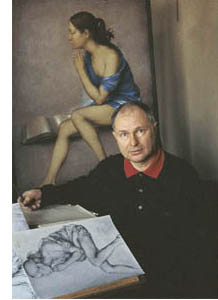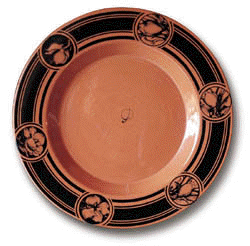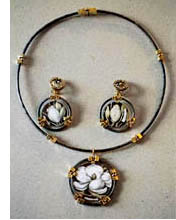 A short while ago, on the occasion of the
exhibition La mia Bergamo (My Bergamo), I wrote of the emotion one feels
on entering Mario Donizetti’s house: “…no less than his painting, the
wonderful house reveals an absolutely unmistakeable and unique sensitivity”,
and I also gave Ermanno Olmi’s testimony: “Simply open the doors of his
home to understand the enormous human depth of the artist we are looking at. The
objects and colours define a rigorous personality more than any words could”.
A short while ago, on the occasion of the
exhibition La mia Bergamo (My Bergamo), I wrote of the emotion one feels
on entering Mario Donizetti’s house: “…no less than his painting, the
wonderful house reveals an absolutely unmistakeable and unique sensitivity”,
and I also gave Ermanno Olmi’s testimony: “Simply open the doors of his
home to understand the enormous human depth of the artist we are looking at. The
objects and colours define a rigorous personality more than any words could”.
Those colours, those objects are now on exhibition at the Arsmedia Gallery, in Bergamo, in Piazza Accademia Carrara, just a step away from the Museum of Modern and Contemporary Art where, in the Rooms of the Spajani Collection, just recently the painting by Donizetti, Theatrical People rediscover the Commedia dell’Arte, has reappeared, restored by the Master himself and brought back to its original splendour.
This design show is the exhibition of small everyday objects transformed into true works of art and, in order of time, is the latest of the challenges which the great Bergamasque artist - perhaps more than any other artist of our time - has known how to take up and win against contemporariness and the problems of contemporariness. This is because in Donizetti there is a firmness in his respect for immortal traditions, a certainty of enduring values, a love of harmony and - to quote Ermanno Olmi’s words again - the essence of foundation...
That essence of foundation which is the scaffolding of all Donizetti’s creating and thinking and which we find in the boldness of his Crucifixes, in the splendour of his nudes, in the beauty of his portraits, in his flowers, and in his landscapes, as in the boldness of his writings on philosophy of art, but also in the boldness of the drawing and design of his everyday objects.
Jewels in gold, silver and iron, ceramic ornaments, wedding boxes or jewellery cases, and bronze bas-reliefs; wrought iron stands, frames, tables and chairs. The “ensembles” of the interiors are also to be observed, the “windows”, the laid tables and the preparatory studies for each of these creations. Observe their elegance: everything is strictly linked to functionality and, therefore, to “design”.
Iacopo Di Bugno
Everyday objects with the stamp of genius
He takes so much care in making the small everyday objects, just as he does in making one of his paintings worthy of being hung - as, in fact, they were in the 1983/84 Anthological Exhibition at the Ambrosiana Art Gallery - alongside major masterpieces. This could be a paraphrase of what Caravaggio asserted: “tanta manifattura gli era a fare un quadro di fiori come di figure (so much handwork did he put into making a picture of flowers as of figures)» then adding that «pittore valent’huomo è colui che sappi dipingere bene et imitar bene le cose naturali (a valiant man is he who knows how to paint well and imitate closely natural things)”.
Those who know Mario Donizetti personally and not just through his paintings, also know the enthusiasm which goes before and follows on all his new ideas, and which remains and grows throughout their realization. Donizetti wants everything that comes from his hands to reveal attention and perfection. Attention which is the other and more perfect name of love. Perfection which concerns the aim and correspondence with the truth of things, so that everyone seeing that object can not only recognise it, but can say it is beautiful; so that everything is “redeemed” from its transience with the aid of the figures. And here one must quote Donizetti himself where, on page 92 of his treatise on aesthetics, Perché figurativo, (Corponove 1992) he upholds that “The perfect representation of a chair prescinds from the beauty or imperfection of the chair as such”.
Through the exhibition of these “everyday objects”, he wants, or rather desires, to enter the homes of those who love beauty and who appreciate his art. He “desires” to remain there, not only in the spirit of a painting hung on the wall, but between their hands or on top of a piece of furniture. He wants, or rather desires, to be the “viaticum” of a gift to people who are dear: to the relatives of the bride and groom, to a newborn baby.
Everyday objects, he calls these small masterpieces, everyday items, wrought iron frames and easels for his paintings, tables, iron and glass stools and chairs, wedding boxes where magnolia branches are entwined, small flowers and small portraits in frames of essential beauty, ceramic plates, boxes of chocolates, where the chocolates themselves have a shape he has given them, the shape, in miniature, of a profile of Gaetano Donizetti in bas-relief - homage dedicated by the painter to the much-loved musician.

 A thread of coincidences unites these two great Bergamasque artists.
A thread of coincidences unites these two great Bergamasque artists.
A thread highlighted by Bruno Lancelot, an art critic in Paris. “Up on the
hill in Bergamo - Lancelot writes - the Donizetti family has aroused
admiration throughout the world since the XIXth century. Today it is Mario
Donizetti, the painter philosopher, who is now honoured - after Gaetano
Donizetti, the famous lyrical composer. Mario has received as many artistic
gifts as his distant ancestor - but in the field of painting - to celebrate some
beautiful female figures in a romantic way. It is said that, on the other hand,
the great musician, as a child, dreamt of becoming a painter, just in the same
way that Mario wished to be a musician”.
We
shall not say who Donizetti is, nor what he has done, nor what he has written,
nor what is said about him, but at least let us tell of the amazement - even for
those who have known him well for decades - when, apart from the two frescoes, The
Resurrection of Lazarus and The Prodigal Son, in the Basilica of
Pontida, they see the beautiful altarpiece of Saint Joseph which
Donizetti painted when he was not yet twenty, in such an innovative and yet
deeply traditional way, even at Scriptural level, that neither schooling nor
modern times can have suggested to him, but solely his genius.
Silvana
Milesi